Science Highlights, April 29, 2015
Awards and Recognition
Materials Physics and Applications
¬Valence fluctuations trigger superconductivity in a plutonium compound
Awards and Recognition
Ellen Cerreta joins ASM Board of Trustees
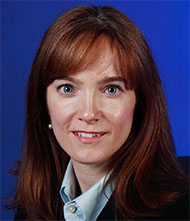
Ellen Cerreta
Materials Science in Radiation and Dynamics Extremes (MST-8) Group Leader Ellen Cerreta will begin a three-year term as an ASM International Trustee in June. The ASM Board of Trustees guides the course of the society – defining its ideals and activities, approving budgets, choosing the managing director, and advising ASM’s top leadership. The Board includes four officers and nine trustees.
Cerreta received a PhD in materials science and engineering from Carnegie Mellon University, and then joined the Laboratory in 2001 as a postdoctoral research associate. She became a staff member in 2003, and MST-8 deputy group leader in 2013. Cerreta was named MST-8 group leader in March 2014. At Los Alamos, she studies dynamic damage due to shock loading and shear deformation of metals. Cerreta leads research into the deterministic features of dynamic failure with the goal of developing damage-tolerant materials for aerospace, defense, automotive, and manufacturing applications. She has held leadership roles at Los Alamos, ASM, and TMS (The Minerals, Metals & Materials Society). Cerreta has served on the Board of Directors for TMS from 2009 to 2012.
ASM International is the world’s largest association of metals-centric materials engineers and scientists. Through publications, databases, and events, the organization informs, educates, and connects the materials community to solve problems and stimulate innovation around the world. Jim Foley (Metallurgy, MST-6) was the previous trustee from the Laboratory, serving from 2012 to 2015. Technical contact: Ellen Cerreta
Panayotis Kevkrekidis serves as Stanislaw M. Ulam Distinguished Scholar
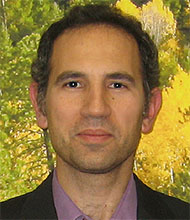
Panayotis Kevkrekidis
Panayotis Kevkredidis of the University of Massachusetts – Amherst is the Stanislaw M. Ulam Distinguished Scholar for fiscal year 2015. Each year, the Lab’s Center for Nonlinear Studies (CNLS) brings a noted scientist to Los Alamos to conduct research at CNLS. The Ulam Scholarship honors the memory of the brilliant Polish-American mathematician Stanislaw Ulam, who was among the founders of what is known as “nonlinear science”. Kevrekidis is visiting CNLS until the end of September 2015 and presenting a number of seminars.
Kevrekidis earned a PhD from the Rutgers University in physics, followed by post-doctoral research with Princeton University and Los Alamos. He is now a Full Professor at the University of Massachusetts. Kevrekidis studies the nonlinear dynamics of solitary waves in continuum nonlinear partial differential equations and in lattice nonlinear differential difference equations and the properties of these waves. He applies such tools and techniques to systems from physics (nonlinear optics and atomic physics) and materials science (granular crystals). Additional interests include mathematical modeling of tumor dynamics and dynamics of reaction-diffusion systems. He has published over 450 research papers in nonlinear physics and applied mathematics and has authored four books. Kevrekidis has received a CAREER award in Applied Mathematics from the National Science Foundation, Humboldt Research Fellowship, Outstanding Paper Prize from the Society for Industrial and Applied Mathematics (SIAM), biennial International Stephanos Pnevmatikos Award, J. D. Crawford Prize of SIAM’s Activity Group in Dynamical Systems, and A. F. Pallas award. The National Science Foundation, U.S. Air Force, and private Foundations (Alexander von Humboldt, Eppley Foundation for Research, U.S.-Israel Binational Science Foundation, and Alexander S. Onassis Public Benefit Foundation) have funded his research. Technical contact: Robert Ecke
Edwin Fohtung named 2015 Rosen Scholar
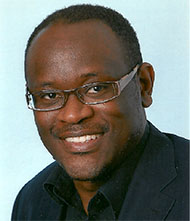
Kurt Schoenberg
Edwin Fohtung is the 2015 Rosen Scholar at the Los Alamos Neutron Science Center (LANSCE) at TA-53. The Rosen Scholar is a fellowship created to honor the memory of renowned LANL physicist Louis Rosen – his accomplishment, work, and appreciation for the broad range of science performed at LANSCE.
A materials physicist, Fohtung is the current LANSCE Professor in conjunction with the Department of Physics at New Mexico State University. He received a PhD from the University of Freiburg in Germany. Fohtung uses experimental and numerical modeling to explore neutron and coherent scattering techniques, laser-based pump-probe experimental techniques, and pulsed electric and magnetic fields to probe emergent soft and condensed matter systems. He investigates multiferroics, magnetoelectric, electronic, straintronics, and magnetic phases arising due to competing and/or coupled charge, spin, orbital ordering and lattice interactions. Fohtung also provides scientific consultation for Matter Radiation Interaction in Extremes (MaRIE), the Laboratory’s proposed signature facility. He guest edited the Journal of Optics special issue on “Coherent Diffractive Imaging”, serves as a member on the Oak Ridge National Laboratory Neutron Sciences Review Committee, and received a Department of Defense Air Force Office of Scientific Research award.
Known as the father of the Neutron Science Center at TA-53, Rosen enjoyed a long and prestigious career at the Laboratory that spanned six-and-a-half decade beginning with the Manhattan Project. His outstanding leadership and scientific career at Los Alamos included conception of the Los Alamos Meson Physics Facility (LAMPF) during 1960, which culminated with its commissioning in 1972. LAMPF was a unique nuclear science research tool through the 1990s. Now called LANSCE, the facility continues to play a paramount role in basic sciences and national security needs for the country. The Laboratory hosted “Rosenfest” to honor Rosen’s legacy in May 2011.
LANSCE provides the scientific community with intense sources of neutrons for experiments supporting civilian and national security research. The DOE, National Nuclear Security Administration, Office of Science and Office of Nuclear Energy, Science and Technology – the principal sponsors of LANSCE – have synergistic long-term needs for the accelerator and neutron science that is the heart of LANSCE. Technical contact: Kurt Schoenberg
Kathy Prestridge expands APS diversity goals for women in physics
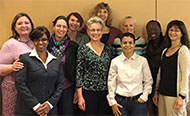
Photo. Participants in the first Train the Trainer Workshop. Kathy Prestridge (LANL, Chair CSWP, fluid dynamics), Donna Stokes (University of Houston, solid state physics), Allena Opper (Jefferson Laboratory, National Science Foundation, nuclear physics); Pearl Sandick (University of Utah, cosmology), Susan Blessing (Florida State University, high energy physics), Nancy Houfek (Professional Trainer), Kawtar Hafidi (Argonne National Laboratory, nuclear physics), Sherry Yennello (Texas A&M University, nuclear physics), Josee Vedrine-Pauleus (University of Puerto Rico – Humacao, condensed matter physics), and Karen Daniels (North Carolina State University, soft matter physics).
In her role as chair of the American Physical Society’s (APS) Committee on the Status of Women in Physics (CSWP), Kathy Prestridge, (Neutron Science and Technology, P-23) recently briefed the Society’s Council, including CEO Kate Kirby and President Samuel Aronson, on CSWP goals and activities, many of which have been expanded under her leadership. To focus the committee’s activities and increase the impact on diversity in physics, the updated goals are to:
- Increase the fraction of women in physics by increasing the number who enroll in and complete undergraduate physics degrees.
- Understand and implement solutions for gender specific issues such as stereotype threat, unconscious bias, and impostor syndrome that affect the careers of all physicists.
- Enhance professional development opportunities for women in physics such as mentoring, mentor training, and negotiation skills workshops.
- Remedy issues that impact gender inequality in physics by encouraging research into fundamental causes, assessing policies, and advocating good practices.
Programs designed to advance these goals include: the Conferences for Undergraduate Women in Physics, Professional Skills Development Workshops, and Climate Site Visits to physics departments and collaborations. One of the most successful, the Professional Skills Development Workshops, will continue under a new five-year National Science Foundation grant. Principal investigators Theodore Hodapp (American Physical Society), Sherry Yennello (Texas A&M University), and Prestridge are developing Train the Trainer, a new program addressing unconscious bias and teaching negotiation skills to graduate students, postdoctoral researchers, and early-career jobseekers pursuing positions in academia, industry, or national labs.
Nine established leaders in physics who are representative of diverse technical and geographical areas attended the April 10 inaugural workshop in Baltimore, Maryland. These women will give workshops on negotiation and career skills at their home organizations. If your group would like to hold a workshop, please contact Prestridge at kpp@lanl.gov.
Election to the CSWP occurs through nominations to the American Physical Society, with final approval made by the council and invitations extended by the CEO. Questions regarding the CSWP should be addressed to kpp@lanl.gov. Technical contact: Kathy Prestridge
Capability Enhancement
Infrastructure upgrades support LANL’s newest supercomputer, Trinity
The Laboratory is preparing for the installation of Trinity, the newest supercomputer to be housed at Los Alamos’s Strategic Computing Center. When Trinity becomes operational, it will be the first platform able to accommodate finely resolved 3-D calculations for full-scale, end-to-end weapons calculations. The water-cooling system for Trinity is a key part of the infrastructure preparation.
The infrastructure upgrades will enable water-cooling of Trinity using water sourced from the Laboratory’s Sanitary Effluent Reclamation Facility (SERF), instead of city water. The new cooling plant will save millions of gallons of well water per year. The supercomputing room itself takes up 43,500 square feet, almost an acre. Nearly one-quarter of that space (about 10,000 square feet) is dedicated to the warm water-cooling infrastructure to keep the machine’s Haswell and Knights Landing-based nodes cool. This work is part of the Lab’s goal to reduce the amount of water needed to cool supercomputers. Last year, LANL reduced water use for supercomputing by 26%.
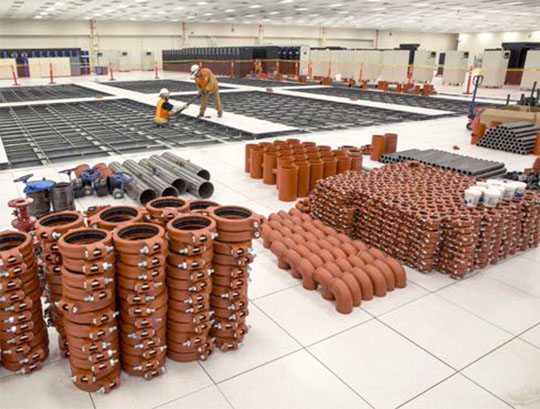

Photos. (Top): Installation of the water-cooling infrastructure to support the new Trinity supercomputer at Los Alamos National Laboratory. (Bottom): Pipes run under the main floor where Trinity will be installed.
The Trinity supercomputer is designed to provide increased computational capability for the NNSA Nuclear Security Enterprise in support of ever-demanding workloads, increasing geometric and physics fidelities while maintaining expectations for total time to solution. The supercomputer will have application performance improvements and larger memory for running more detailed weapons simulations. The capabilities of Trinity support the NNSA Stockpile Stewardship program’s certification and assessments to ensure that the nation’s nuclear stockpile is safe, reliable, and secure.
Trinity will have at least eight times greater applications performance than Cielo, the current NNSA supercomputer at Los Alamos. Trinity is the first Advanced Technology (AT) system for the NNSA Advanced Simulation and Computing (ASC) Program. It will implement the new computing strategy requiring all AT systems to service NNSA mission workload while preparing the ASC applications for transition onto future advanced architectures. A Haswell partition and a Knights Landing partition will comprise the single system. Trinity will introduce the “Burst Buffer” concept and “Advanced Power Management” as part of the platform. The fully integrated system will consist of compute nodes, memory, high speed interconnect and parallel file system. The first testbeds, Trinitite and Gadget, were delivered and installed at LANL in February 2015.
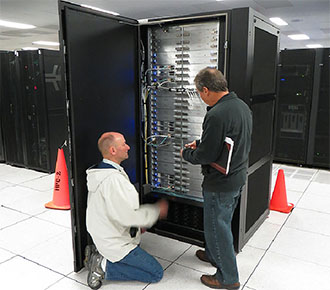
Photo. Trinitite, one of the Trinity testbeds delivered and installed at LANL.
Managed by NNSA, Trinity is a joint effort of the New Mexico Alliance for Computing at Extreme Scale (ACES) between Los Alamos and Sandia national laboratories as part of the NNSA Advanced Simulation and Computing Program. Los Alamos, Lawrence Livermore, and Sandia national laboratories will use Trinity. As part of the procurement, a Center of Excellence for Application Transition has been established. A collaboration of ACES, the tri-labs, Cray, and Intel, the Center will ensure that key ASC applications will port to perform on the Trinity architecture. Trinity supports the Laboratory’s Nuclear Deterrence mission area and the Information, Science, and Technology science pillar through advanced computing capabilities. Manuel Vigil (High Performance Computing, HPC-DO) is the Project Director. Technical contact: Manuel Vigil
Chemistry
Signatures indicating chemical changes in U3O8 for forensic applications
There is a need to develop signatures associated with uranium materials for determining provenance and history of unknown samples for national security applications. These signatures would support a broader range of tools employed for nuclear forensic analyses. Molecular and structural diagnostics have been useful for providing insight into future transport and fate of uranium materials in the environment. Looking back in time, these tools may also deliver information on a material’s provenance and/or intended use. However, fundamental studies are needed before these tools can be verified and validated for proposed use in an investigative forensic process. The development of chemical materials standards of stable materials is equally important. Los Alamos researchers and collaborators are addressing both of these problems. The journal Analytical Chemistry published their findings.
Chemical signatures may develop from processes used to manufacture nuclear materials or from storage of the materials. The team used tools commonly employed to measure chemical structures. The researchers characterized high-purity triuranium ocatoxide (U3O8, an uranium oxide intermediate in nuclear conversion processes) and U3O8 materials that contained chemical impurities common to conversion processes. They reported the type of information accessible for these materials through powder x-ray diffraction analysis and x-ray absorption spectroscopy. The scientists also probed changes in chemical speciation after storage of these materials for up to 3.5 years under controlled temperature and relative humidity conditions representing ambient conditions.
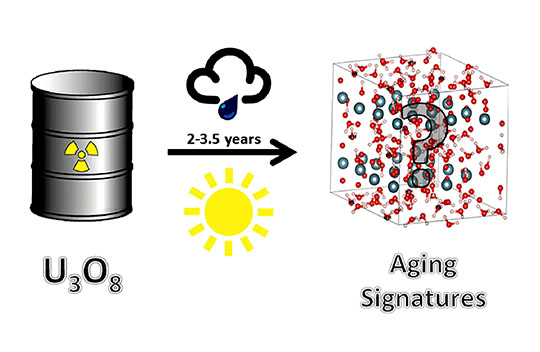
Figure 1. As U3O8 ages, it changes its character based on ambient storage conditions. These changes can provide clues valuable to forensic analysis.
The team observed that some signatures from impurities did not persist over time, perhaps due to masking from other chemical species in the sample or decomposition of the impurities. The researchers measured oxidation and hydration of these U3O8 samples to schoepite species (U3O8 hydrates) and characterized increased disorder in the spectra of these materials. The scientists augmented experimental measurements with density functional theory (DFT) calculations to investigate the structural impact of hydration in schoepites. The team concluded that the humidity under which the sample was stored likely caused these changes. For example, the presence of schoepite phases in older uranium oxide material may indicate storage under high humidity and should be taken into account when assessing sample history during forensic analysis.
Reference: “Oxidation and Hydration of U3O8 Materials Following Controlled Exposure to Temperature and Humidity” Analytical Chemistry (Washington DC) 87, 4210 (2015); doi: 10.1021/ac504105t. Authors include: Alison L. Tamasi (Nuclear and Radiochemistry, C-NR and University of Missouri-Columbia); Kevin S. Boland, Stosh A. Kozimor, and Andrew D. Sutton (Inorganic, Isotope and Actinide Chemistry, C-IIAC); Jason K. Ellis and Richard L. Martin (Physics and Chemistry of Materials, T-1); Alison L. Pugmire (Nuclear Materials Science, MST-16); Brian L. Scott (Materials Synthesis and Integrated Devices, MPA-11); Gregory L. Wagner (Physical Chemistry and Applied Spectroscopy, C-PCS); Marianne P. Wilkerson (C-NR); Justin R. Walensky (University of Missouri-Columbia); Kenneth Czerwinski (University of Nevada-Las Vegas); and Dallas Reilly (Pacific Northwest National Laboratory).
The U.S. Department of Homeland Security, Domestic Nuclear Detection Office, and the Federal Bureau of Investigation funded the work. A Los Alamos National Laboratory Seaborg Institute Fellowship sponsored Jason Ellis. The research supports the Lab’s Global Security mission area and the Science of Signatures science pillar through knowledge of chemical signatures for nuclear forensic analysis applications. Technical contact: Marianne Wilkerson
Earth and Environmental Sciences
Locating sources of natural and anthropogenic infrasound events
Geophysics (EES-17) scientists and collaborators described acoustic and infrasound properties and their application to seismic monitoring and test-ban treaty verification in two papers published in the Geophysical Journal International. EES-17 led the studies in collaboration with the Atomic Weapons Establishment – Blacknest (Reading, UK) and the Space Sciences Division at the U.S. Naval Research Laboratory.
Bayesian infrasound source localization (BISL) is one method that is used to detect, locate, and characterize natural and manmade sources of infrasound (sound with frequencies below the audible human range). The first paper incorporates semi-empirical model-based information to demonstrate improvements in the precision of the BISL method. BISL uses backazimuths and delay times at two or more sensor arrays to scan an area for the most likely solution. One advantage of BISL is its flexibility – prior information can be incorporated to constrain parameters. The team generated model-based propagation catalogues using a comprehensive set of atmospheric scenarios, extracted celerity (speed) distributions, and used these distributions as prior probability density functions (PDFs) to enhance future location solutions derived from BISL. The team demonstrated improvements in source location. They compared BISL results computed using celerity distribution priors with those using enhanced priors in two scenarios; the first is a set of events recorded across a regional network (Figure 2), and the second is a large accidental chemical explosion recorded by infrasound arrays in Eurasia. The authors show that implementing azimuth and range-dependent prior information for celerity greatly enhances the precision of the BISL method.
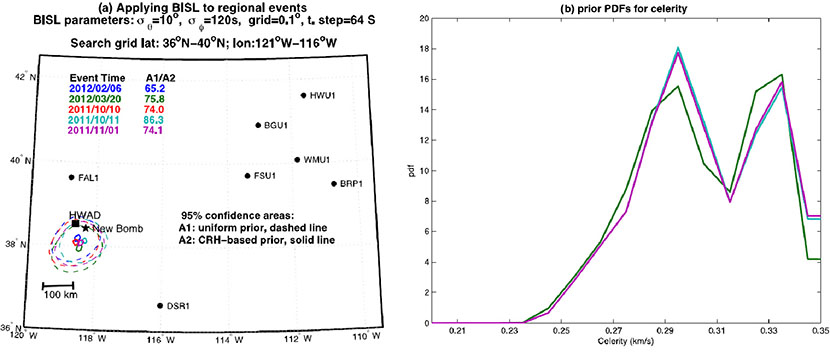
Figure 2. Using uniform and celerity range histogram (CRH)-based prior PDFs for localization with BISL for events recorded at regional distances. (Left image): Location of detection arrays in Utah and Nevada (black dots) 95% confidence areas using uniform (dashed) and CRH-based (solid) priors. “New Bomb” (black star) is one of the detonation sites tested in the publication; this location is part of the Hawthorne Army Ammunition Depot (HWAD, black square). (Right image): CRH-based prior PDFs corresponding to the maximum observed points for each event localization. The PDFs for the February 2012 (blue) and October 2011 (red) events are similar to the March 2012 (green) and November 2011 (pink) events, respectively.
Reference: “Using Physics-based Priors in a Bayesian Algorithm to Enhance Infrasound Source Location,” Geophysical Journal International 196, 375 (2014); doi: 10.1093/gji/ggt353. Authors include: Omar Marcillo, Stephen Arrowsmith, Rod Whitaker, and Dale Anderson (EES-17); Alexandra Nippress and David Green (Atomic Weapons Establishment - Blacknest); and Douglas Drob (U.S. Naval Research Laboratory).
The second paper presents methods for detecting, associating, and locating infrasound events recorded on the global International Monitoring System (IMS), which is part of the Comprehensive Nuclear Test Ban Treaty Organization’s nuclear verification regime. The International Monitoring System processes a large amount of data each day, and false alarms are common. The paper outlines a framework for processing IMS data to: 1) detect low-yield atmospheric tests, which may not be detected any other way; and 2) minimize false detections.
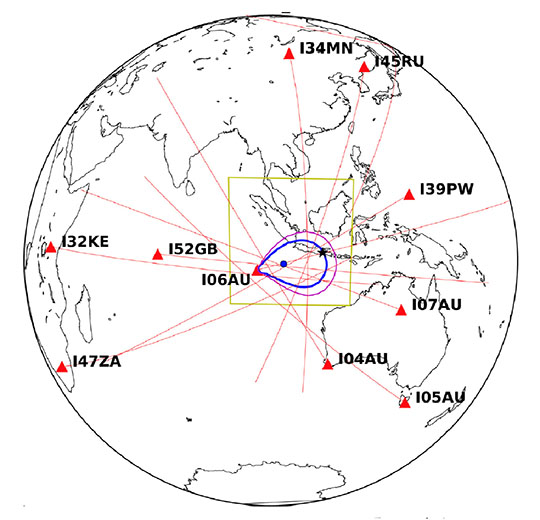
Figure 3. Automatic location solution for a 2-day period corresponding to February 13-14, 2014. The Kelud volcano erupted in Indonesia on February 13, 2014. The blue dot depicts the maximum empirical location, 95 and 99 percent credibility contours are depicted by blue and magenta polygons, respectively, and red triangles depict detection stations. Red lines are the projections of estimated backazimuths along their great circle paths. The black star denotes the actual location of the Kelud volcano; yellow box denotes the BISL search region defined based on association solution. Crosswinds biased the 95 and 99 per cent credibility contours towards the west of the event.
Likelihood arguments and reducing the use of empirically determined parameters enabled the authors to calculate confidence areas for event localization as well as formally quantify the false alarm rate at both station and network levels. The authors used Monte Carlo simulations to assess the performance of a new association technique that uses graph theory for association arrivals at multiple spatially separated stations. They applied this new association technique, as well as detection and location techniques, to 10 large events that the International Monitoring System had detected. Out of the 10 events analyzed in this paper, the combined method automatically detected and associated seven. The team analyzed the three missing events and identified improvements that could refine the algorithms.
Reference: “Development of a Robust and Automated Infrasound Event Catalogue Using the International Monitoring System,” Geophysical Journal International 200, 1411 (2015); doi: 10.1093/gji/ggu486. Authors include: Stephen Arrowsmith, Garrett Euler, Omar Marcillo, Philip Blom, Rod Whitaker, and George Randall (EES-17).
NNSA NA-22 funded the research, which supports the Lab’s Global Security mission area and the Information, Science, and Technology and the Science of Signatures science pillars through the application to seismic monitoring and test-ban treaty verification. Technical contact: Dale Anderson
Materials Physics and Applications
¬Valence fluctuations trigger superconductivity in a plutonium compound
Los Alamos researchers have pinpointed the mechanism behind superconductivity in plutonium-cobalt-gallium5 (PuCoGa5), a compound with a surprisingly high superconducting transition temperature. The team leveraged the power of resonant ultrasound spectroscopy (RUS) to probe a sample from room temperature to 10 degrees above absolute zero (Kelvin). This discovery, in a heavy-Fermion compound first identified at the Lab more than a decade ago, helps scientists understand which material properties lead to high superconducting transition temperatures. Their ultimate goal is to design a room-temperature superconductor. Room-temperature superconductors are of interest from a fundamental scientific perspective as well as for a variety of applications including superconducting magnets for cheaper and more powerful magnetic resonance imaging (MRI).
In ordinary members of the heavy-fermion superconductor family, scientists seek new superconductors by suppressing magnetism and activating superconductivity through spin-fluctuations. However, PuCoGa5 does not have the required magnetism to support this mechanism of superconductivity. According to Los Alamos research published in the Proceedings of the National Academy of Sciences, plutonium valence fluctuations are key to understanding the source of high-temperature superconductivity in PuCoGa5, the highest Tc superconductor of the heavy fermions, with a Tc of 18.5 K. (Tc refers to the critical temperature below which a superconductor must cool in order to exhibit this unusual state of matter in which electrical current flows without resistance as a result of the material’s electrons acting in pairs.) A critical component of the discovery was the observation that the valence fluctuations disappear at Tc. This finding suggests that the same electrons that participate in the valence fluctuations also participate in superconductivity, providing a direct link between the two phenomena.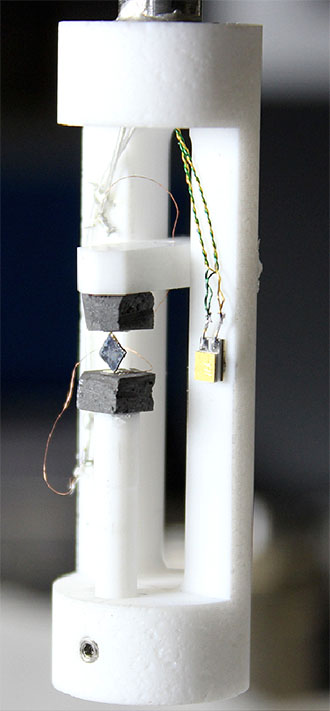
Photo. The Lab team used this probe to locate the mechanism behind superconductivity in plutonium-cobalt-gallium5.
The researchers found that that the bulk modulus softens anomalously over a wide range in temperature above Tc. The elastic symmetry channel in which this softening occurs is characteristic of a valence instability. Therefore, the team identified the elastic softening with fluctuations of the plutonium 5f mixed-valence state. These valence fluctuations disappear when the superconducting gap opens at Tc. This result suggests that electrons near the Fermi surface play an essential role in the mixed-valence physics of this system and that PuCoGa5 avoids a valence transition by entering the superconducting state. The lack of magnetism in PuCoGa5 has made it difficult to reconcile with most other heavy-fermion superconductors, where superconductivity appears to be mediated by magnetic fluctuations. The new observations suggest that valence fluctuations play a critical role in the unusually high Tc of PuCoGa5.
Reference: “Avoided Valence Transition in a Plutonium Superconductor,” Proceedings of the National Academy of Sciences 112, 3285 (2015); published online before print March 3, 2015, doi: 10.1073/pnas.1421174112. Authors: Brad Ramshaw, Ross McDonald, Jon Betts, Chuck Mielke, and Eric Bauer (Condensed Matter and Magnet Science, MPA-CMMS); Arkady Shekhter (MPA-CMMS, now with NHMFL-Tallahassee); Jeremy Mitchell and Paul Tobash (Nuclear Materials Science, MST-16); and Albert Migliori (National Security Education Center, NSEC).
Work at Los Alamos National Laboratory was performed under the auspices of the DOE, Basic Energy Sciences, Division of Materials Sciences and Engineering, and the LANL Laboratory Directed Research and Development (LDRD) Program. This work was conducted at the National High Magnetic Field Laboratory, which the National Science Foundation and the State of Florida fund. The research supports the Lab’s Energy Security mission area and Materials for the Future science pillar through the development of materials for energy applications. Technical contact: Brad Ramshaw









